RESEARCH

RESEARCH
DARRTOWN POST OFFICE HISTORY
Community Militia Sports Hitching Post Post Office Return to Events page
Item 1- Year 1860: An excerpt from the 1860 U.S. Census lists John McMaken as the Darrtown Postmaster
item 2 - Year 1865: A request for information from the Darrtown Postmaster regarding the "relative position of Post Offices"
Item 3 - Year 1898: A request for information from the Darrtown Postmaster regarding the "relative position of Post Offices"
Item 4 - Year 1916: A letter to the editor which asserts that the Darrtown rural free delivery system preceded that of Collinsville and Somerville
Item 5 - Year 1935: A letter from Harllee Branch, Second Assistant Postmaster General (Washington, DC), which clarifies that "the first rural delivery service in Ohio was established at Collinsville, Darrtown, and Somerville, effective October 1, 1896."
Item 6 - Year 1956: A newspaper article describes an interview of Darrtown watchmaker, William K. Bufler, who remembers when Darrtown had its own post office.
Item 7 - Year 2012: Information from the United States Postal Service, that confirms Darrtown, Collinsville and Somerville were the first RFD (rural free delivery) routes IN OHIO.
Item 8 - Year 2012: A list of Darrtown Postmasters (from 1825 to 1901) that was compiled and contributed by Thomas F. Stander, Butler County (Ohio) historian
Item 9 - Year 2012: Front and back of an 1897 envelope sent from Reily, Ohio to Darrtown, Ohio
Item 10 - Year 2012: Front and back of a 1900 envelope sent from Reily, Ohio to Darrtown, Ohio

The following image, taken from the 1860 U.S. Federal census, shows the occupation of John McMaken, age 50, as "postmaster." The names that appeared on lines above and below this section of the census were names of Darrtown residents. Therefore, it seems reasonable to assume that John McMaken was the postmaster of the Darrtown post office. Others listed at the residence of John McMaken were Mary E. McMaken, age 57, and M. S. Leopold, a female, age 18.
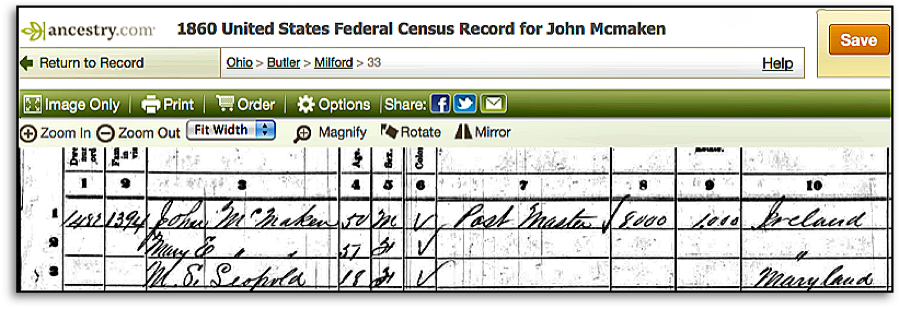
A complete listing of Darrtown postmasters appears in Item 8, below.


The following image displays an 1865 form letter from Geo. W. McLellan, the Second Assistant Postmaster General, in Washington, D.C. wherein Mr. McLellan requests information from the Darrtown Postmaster regarding the "relative position of Post Offices." John McCechan, Darrtown postmaster responded.
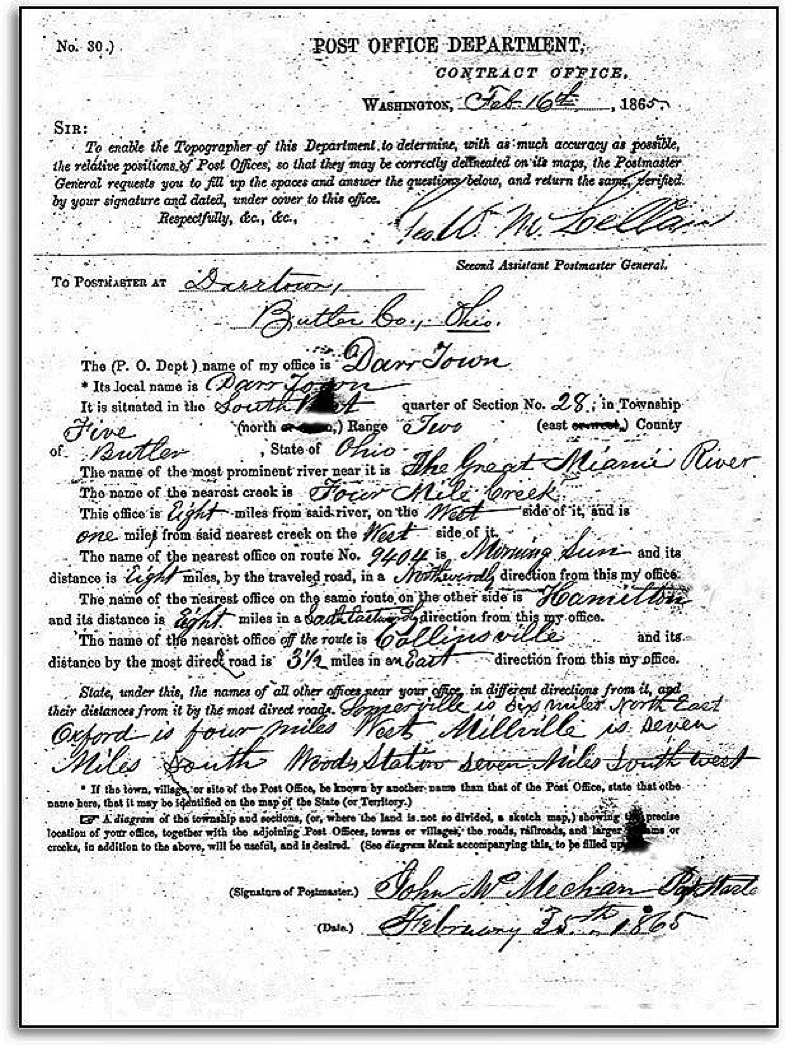

The following image displays an 1898 form letter from a topographer in the P. O. Department, in Washington, D.C. wherein the topographer requests information from the Darrtown Postmaster regarding the "relative position of Post Offices." William J. Brincefield, Darrtown postmaster responded.

Rick Martin, Darrtown native, contributed two items related to the delivery of mail in and around Darrtown:
The following "Letter to the editor" appeared in the January 26, 1916 edition of the Hamilton (Ohio) Republcan News.
" 'Letter to Editor' Asserts that Darrtown Rural Free Delivery Preceded both the Somerville and Collinsville Rural Free Delivery
To the editor of the Daily Republican News:
My attention was called to an article in your issue of Jan. 17, in reference to the services of J. W. Morton, rural route mail carrier. Your article states that he was appointed to his present position on October 15, 1896 and was the first mail carrier to cover a rural route in Ohio, if not in the United States.
Permit me to say your information is badly mistaken. The first route was established at Darrtown in the latter part of October 1896 and C. G. Hagen, who is now a fireman at the Cincinnati Brewing Co.'s plant, was the first carrier.
Along in the early part of October 1896, Congress, after a good deal of quarreling, rangling, and much discussion, finally appropriated a sum of money for experimental purposes in the rural free delivery system. A large percentage of the population thought it would be a failure and hence did not take interest enough in the project to make a fight for it. The salary was $25 per month.
After some days, Postmaster General Wanamaker was undecided as to where to try the scheme. [1] One day, Gov. Campbell stepped into the Postmaster General's office and Wannamaker at once asked him where would be a good place to put the route question in operation. Gov. Campbell suggested Butler Co., Ohio and stated, "It was the best county in the world." [2] General Wannamaker acted on the suggestion and immediately dispatched W. L. Moore to Hamilton. Inspector Moore and J. E. Lohman discussed the matter and the result was the first route was established in Darrtown, as stated. A few hours after this, another was mapped out about Somerville and several days after this, one was established at Collinsville. So, this statement about Oct. 15 1896 is also wrong.
The first piece of mail delivered to any person by the rural route system anywhere in Ohio was handed to Mr. John Bradbury, who lived east of Darrtown. [3]
Mr. Hagen started on his route the latter part of October. The people in the district did not take to the system, with the result that Mr. Hagen was very much inconvenienced and had to do a lot of extra work in order to carry out his obligations. Some refused to recognize the system and refused to place boxes in front of their residences, this necessitating the walking to the house.
Mr. Hagan managed the route for a year or so by himself; then he came to this city during the summer months and left the route in charge of his wife. The was never any kicks, as long as she had it, so you can see there are other veterans of this system in its infancy that can say, "Well done, good and faithful servant."
In order to show you how the people appreciated this mastodonic political scheme, Mrs. Hagan, after a hard rain one morning, was compelled to mount a board fence and travel from post to post for some distance to reach a soap box that the farmer had nailed on top of a post. At this day, the country folk believed that they could get along without it.
Mr. Hagan, on his first trip had some twenty-two or twenty-four pieces of mail which he delivered on foot with a basket. After the appointment had been made in Darrtown, and the Collinsville and Somerville routes arranged for, the Collinsville appointment was delayed two or three days; so Mr. Hagan, at Darrtown, and Mr. Wagner, at Somerville were traveling their routes, before Mr. Morton was appointed. So, it seems he was the third and the people had become accustomed to rural delivery.
Mrs. Hagan was given bond and was the first woman rural route mail carrier in Ohio and the second, as far as the facts are available, in the United States. [4]
Charles E. Davis"
Webmaster Notes:
Given the information that appears in Items 5 and 7 (below), the letter to the editor, at the left, must stand alone - i. e., it is solely the author's perception of the events that he described in his letter.
[1] A United States Postal Service webpage that provides info about RFD (Rural Free Delivery) credits Postmaster William L. Wilson (not John Wanamaker) for implementing the RFD experiment.
[2] The [2] "Gov. Campbell" to which the letter writer refers was (probably) Gov. James E. Campbell, 38th governor of Ohio and three-term member of the U. S. House of Representatives, who was born in Middletown, Ohio. As a Butler county native, it seems believable that he might claim Butler county as the "best in the world."
[3] An image of the Bradbury residence, on Scott Road, east of Darrtown, is seen at Families/Bradbury.
[4] The obituary of Mrs. Hagan (first name not found) appeared in the April 29, 1921 edition of the Hamilton Evening Journal and included this sentence: "The greater part of her life was spent in this village and she and her husband were the first rural mail carriers in this vicinity."

The image below shows a letter from Mr. Harllee Branch, Second Assistant Postmaster General (Washington, DC) to Mr. Otto Kersteiner of Hamilton, Ohio in which Mr. Branch confirms that "the first rural delivery service in Ohio was established at Collinsville, Darrtown, and Somerville, effective October 1, 1896."
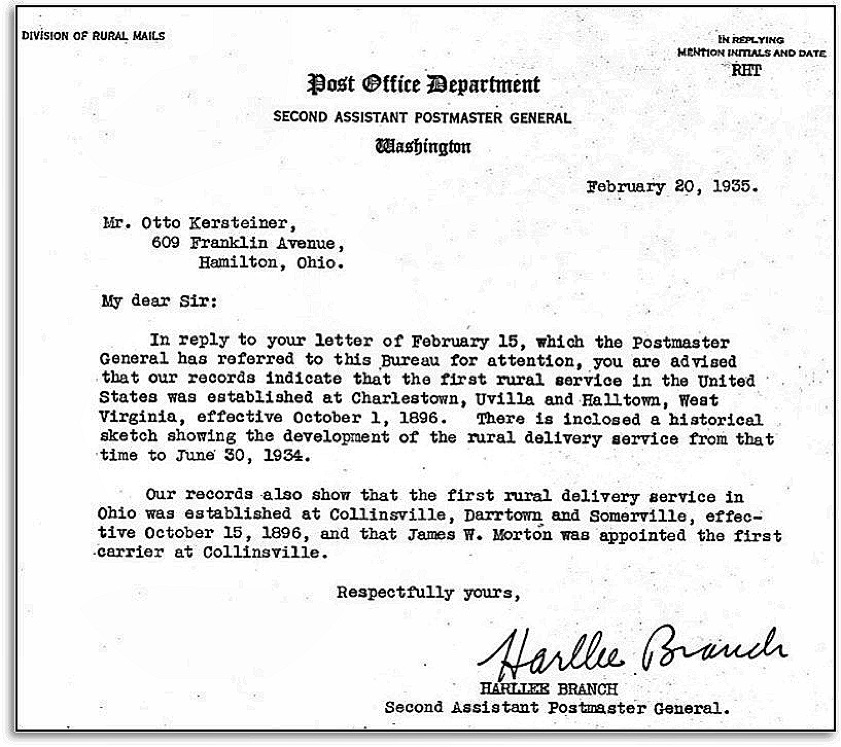

The following image displays a 1956 newspaper article that describes an interview of Darrtown watchmaker, William K. Bufler, who remembers when Darrtown had its own post office. The entire article appears at Organizations / Businesses / 5.
"William 'Bink' Bufler Recalls Darrtown Post Office
He remembers Darrtown when it was an active little town with a hotel, blacksmith and wagon-maker shops, a saw mill, and four saloons.
'There used to be a race track over that way,' he said, pointing across the main street. 'Darrtown used to have a post office, too and the toll road went through here.' He said many of the old timers are gone, but there are still a few, such as the Kigers and the Ramseys.
'I remember when they used to drive a team of horses to Oxford to get the mail for the post office,' he said. He believes the town receded more rapidly than normal, after the Darrtown school was closed and the youngsters consolidated with Oxford."

The following quotation, found at the United States Postal Service website, introduces the chart (RIGHT) that lists "Dates of first rural free delivery of mail, by U.S. states."
THE CHART AT THE RIGHT "is a list of the establishment dates of the first rural route(s) in each state, along with the names of the Post Offices served.
Lists of dates that the first rural routes were established at Post Offices through December 31, 1904, by state, can be accessed by clicking on the “PDF” or “RTF” file for the state. These lists were compiled using data from the 1901 Annual Report of the Postmaster General and issues of the Postal Bulletin through 1904. Lists for Alaska and Hawaii are not available.
These lists are intended as guides only—all of the dates have not been verified. In some instances more than one date is listed for the establishment of service at a particular Post Office. Verification of rural route establishment dates and further details on specific routes may be available from the National Personnel Records Center, Civilian Personnel Records."
Establishment dates for first rural free delivery of mail - by U.S. states


List of Darrtown postmasters
RIGHT:
In 2012, Thomas F. Stander, Butler County (Ohio) historian, contributed three items to this website.
The first item appears at the right and the other two appear below.


In 2012, Thomas F. Stander, Butler County (Ohio) historian, contributed the following images (front and back sides) of an 1897 envelope sent from Reily, Ohio post office to the Darrtown post office.
In 2012, Thomas F. Stander, Butler County (Ohio) historian, contributed the following images (front and back sides) of a 1900 envelope sent from Reily, Ohio post office to the Darrtown post office.
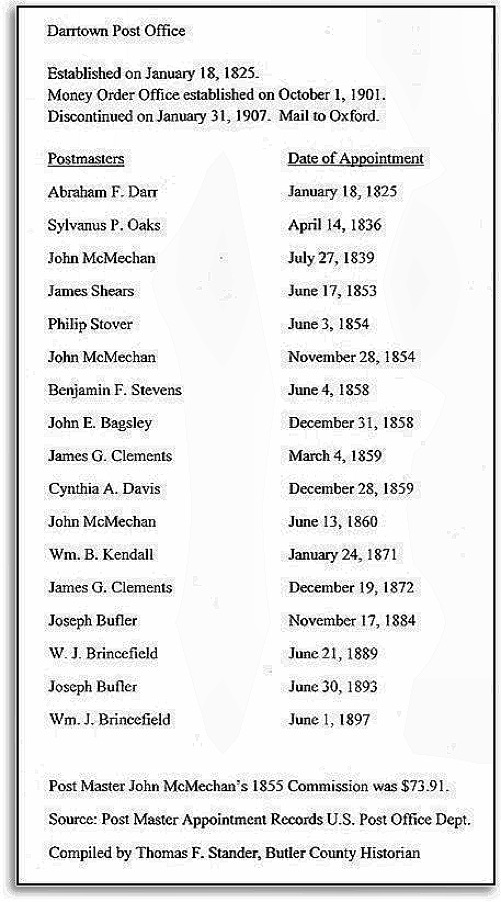
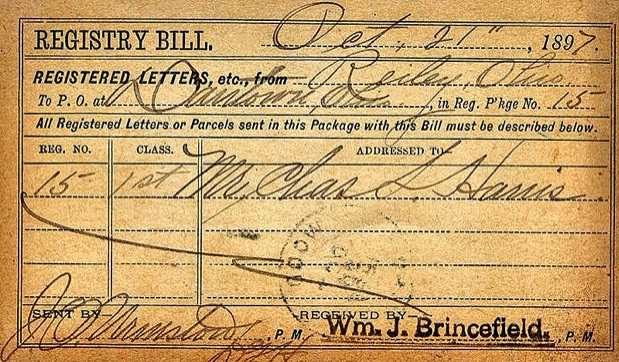
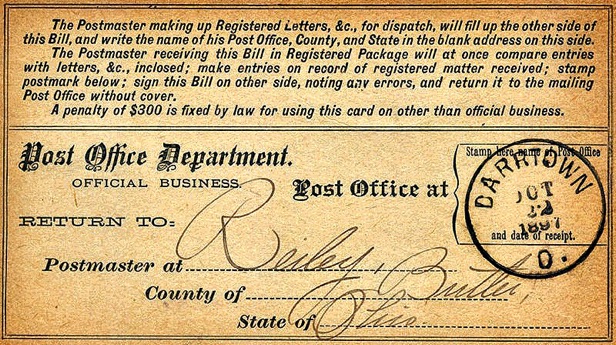
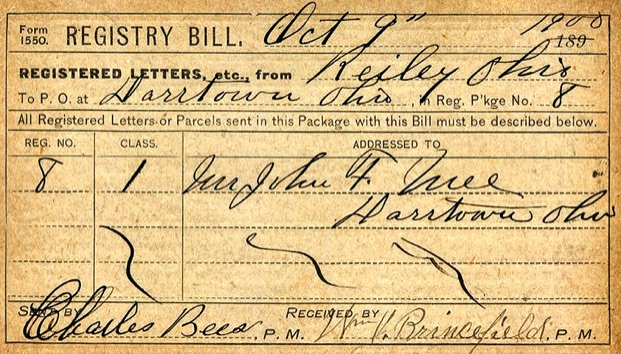

The majority of content on this page relates to the Darrtown post office, which opened in 1825 and closed in 1907.
Some information on this page relates to the provision of Rural Free Delivery of mail to areas nearby Darrtown, which began in 1916.
√

A 1901 newspaper article announced the creation of three new RFD routes in the Hamilton, Ohio area.
√
√
The discovery of a 1930 news item verified that the Darrtown post office was located in the home of John and Maria Nichol.
In early days, United States post offices were commonly located in stores, taverns, and/or the homes of the persons who served as postmasters. See: Location of Darrtown post offices.



DARRTOWN, OHIO
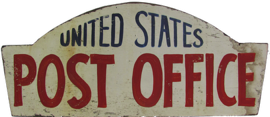
WEBMASTER NOTE: The 10/15/1896 date (above) for RFD service at Collinsville, Darrtown, and Somerville conflicts with the Davis letter (item 4 above) which describes Darrtown as receiving such service before the two other Milford Township villages.
1897 Newspaper Article Confirms RFD Experiment at Darrtown, Collinsville, and Somerville
The following link reveals an 1897 Cincinnati Enquirer news item about the first RFD service in Ohio - which was considered to be a test of the "rural free delivery" system.
Excerpt from U.S. Postal Service website provides history of Rural Free Delivery
POSTAL HISTORY - RURAL FREE DELIVERY In January 1892, Congressman James O’Donnell introduced “A Bill to Extend the Free Delivery System of Mails to Rural Communities,” but the House Committee on Post Office and Post Roads balked at the proposed $6 million price tag. An amendment bringing the figure down to $100,000 also was rejected. A year and two months later, on March 3, 1893, a bill, introduced by one-term Georgia Congressman Tom Watson, passed. It appropriated $10,000 for experimental rural free delivery. On March 6, 1893, Wilson S. Bissell was sworn in as Postmaster General. He did not pursue the experiment, citing the pressure of more important concerns and the need for at least $20 million to inaugurate rural free delivery, a figure later identified as a guess. Instead, he recommended establishing additional Post Offices where needed. Bissell was succeeded by William L. Wilson on March 1, 1895. Wilson agreed with his predecessor that rural free delivery was not practical; but, was willing to attempt the experiment, if Congress made money available. That year, Congress appropriated $20,000 for the experiment and another $10,000 in 1896, bringing the total to $40,000 — enough for the Post Office Department to begin its rural free delivery experiment. On October 1, 1896, rural free delivery (RFD) service began in Charles Town, Halltown, and Uvilla in West Virginia, Postmaster General Wilson's home state. Within a year, 44 routes were operating in 29 states.
The complete summary is available at: U.S. Postal History of RFD
Establishment dates of first rural free delivery of mail in Ohio
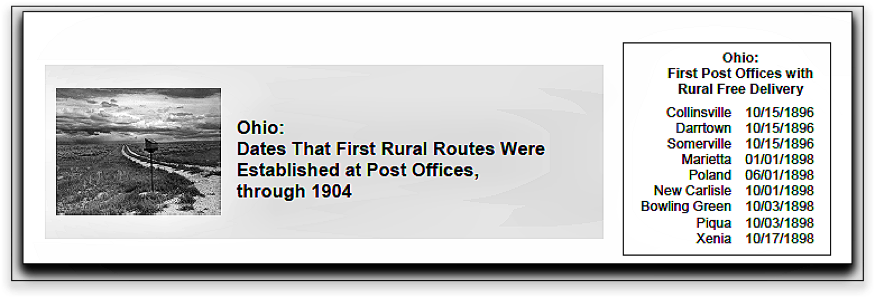
The following information, found at the United States Postal Service website, verifies that Darrtown, Collinsville and Somerville were first RFD (rural free delivery) routes in Ohio and that they began on the same date.
(2) an obituary of Mrs. Cliff Hagen - the wife of a former Darrtown postmaster. Mrs. Hagen's obituary appears at: People / Individuals / H-L.
(1) a letter to the editor (displayed below) that asserts the first rural free delivery occurred in Darrtown (not Collinsville or Somerville).

